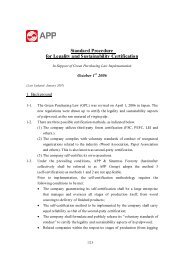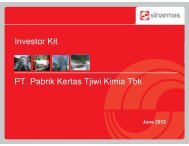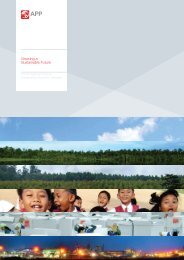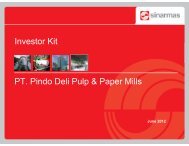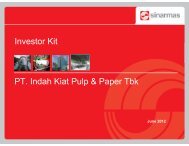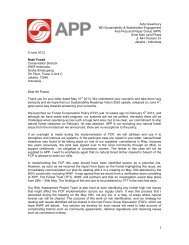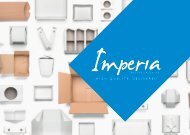APP Sustainability Report 2008-2009 - Asia Pulp and Paper
APP Sustainability Report 2008-2009 - Asia Pulp and Paper
APP Sustainability Report 2008-2009 - Asia Pulp and Paper
You also want an ePaper? Increase the reach of your titles
YUMPU automatically turns print PDFs into web optimized ePapers that Google loves.
Sustainable Products<br />
Sustainable Products<br />
Ekamas Fortuna<br />
Overview <strong>and</strong> Background<br />
<strong>APP</strong>’s Ekamas Fortuna mill is located in Desa<br />
Gampingan village, some 35 km south of<br />
Malang in East Java, <strong>and</strong> was established<br />
in 1984 on a 25-hectare scrubl<strong>and</strong> site,<br />
adjacent to the Les River. It was originally<br />
constructed by a Malang-based cigaree<br />
manufacturer to produce outer cartons for<br />
use as delivery packaging for its products.<br />
Inially the mill had one 2.5- metre-wide,<br />
20,000 tonne/annum mul-vat board<br />
machine, with a second 3.9 metre-wide twinwire<br />
fourdrinier machine added in 1991.<br />
The mill went into receivership in July 1993,<br />
just as an expansion of the second machine<br />
to more than 110,000 tonnes/annum was<br />
being commissioned, <strong>and</strong> was purchased<br />
from the administrators <strong>and</strong> become part of<br />
the <strong>APP</strong> group of companies, in September<br />
1994.<br />
Subsequent upgrades of both paper<br />
machines under <strong>APP</strong>’s ownership, <strong>and</strong><br />
expansion of the mill’s converng capacity<br />
in 2001 has given Ekamas Fortuna a current<br />
nominal producon capacity of about<br />
175,000 tonnes/annum. Authorisaon is in<br />
place for an expansion in capacity to 203,000<br />
tonnes/annum.<br />
The mill is the major employer in its locality.<br />
Table 55 - Employment<br />
<strong>2008</strong> <strong>2009</strong><br />
Direct employees 1,044 1,141<br />
Indirect employees 864 1,141<br />
Statutory Obligaons:<br />
Environmental Permits <strong>and</strong><br />
Compliance Reporng<br />
The mill is regulated under a UKL / UPL<br />
schedule authorised by the KLH (Indonesian<br />
Environment Ministry) office for Malang<br />
Kabupaten, <strong>and</strong> reports its operaonal,<br />
environmental <strong>and</strong> socio-economic<br />
performance to that office on semi-annually<br />
<strong>and</strong> quarterly for waste.<br />
The mill has current cerficaon of its ISO<br />
14001:2004 Environmental Management<br />
System (EMS), due for renewal in 2011. It<br />
improved its rang in the PROPER appraisal<br />
scheme operated by KLH from Red in <strong>2008</strong><br />
to Blue minus in <strong>2009</strong>. The improved rang<br />
resulted from progressive clean-up of open<br />
dumping <strong>and</strong> accumulaon of boiler plant fly<br />
ash <strong>and</strong> boom ash through licensed third<br />
Table 56 - Aggregated Mill Producon<br />
pares, <strong>and</strong> the introducon of brick-making<br />
from it. The mill received a license in <strong>2009</strong><br />
to convert its fly ash <strong>and</strong> boom ash to<br />
bricks <strong>and</strong> paving for internal <strong>and</strong> external<br />
use. In addion, no penales were given to<br />
Ekamas Fortuna for non-compliance with<br />
environmental laws <strong>and</strong> regulaons in <strong>2008</strong><br />
<strong>and</strong> <strong>2009</strong>.<br />
<strong>Paper</strong> Producon<br />
Ekamas Fortuna’s packaging products<br />
include corrugang medium, wrapping<br />
papers, chipboard <strong>and</strong> kra liner. The<br />
relavely small mill occupies a niche market,<br />
selling its mainly “value” grade packaging<br />
predominantly into the Indonesian domesc<br />
market - largely on the isl<strong>and</strong> of Java - with<br />
some 10 percent exported within Southeast<br />
<strong>Asia</strong>. Other value-added products include<br />
seamless <strong>and</strong> non-seamless cores / tubes,<br />
shopping bags, paper cones <strong>and</strong> sheeted<br />
paper. The mill’s products are 100 percent<br />
post-consumer waste-based, with the<br />
excepon of some of its kra wrapping<br />
papers <strong>and</strong> kra liner, which have a<br />
significant virgin unbleached sowood kra<br />
pulp (NUKP) content.<br />
Raw Material Inputs<br />
Waste <strong>Paper</strong><br />
The mill’s principal raw material is postconsumer<br />
wastepaper, which comprises<br />
more than 95 percent of its fibre furnish.<br />
This is obtained both within Indonesia <strong>and</strong><br />
by import from Singapore, the U.S. <strong>and</strong><br />
Europe. Mill broke levels, re-incorporated<br />
into products, averaged 4 percent in both<br />
years.<br />
Purchased <strong>Pulp</strong><br />
Post-consumer waste inputs are augmented<br />
with a much smaller quanty of imported<br />
unbleached sowood kra pulp (NUKP) used<br />
to improve the strength, <strong>and</strong> parcularly<br />
the tear strength, of certain paper grades.<br />
Consumpon in <strong>2008</strong> <strong>and</strong> <strong>2009</strong> was 5,074<br />
tonnes <strong>and</strong> 9,309 tonnes, respecvely.<br />
Ekamas Fortuna occasionally obtains small<br />
quanes of low-grade bleached hardwood<br />
kra pulp (LBKP) from Indah Kiat Perawang<br />
Mill (29 tonnes in <strong>2008</strong>), for use in specific<br />
grades of plasterboard liner.<br />
Starch <strong>and</strong> Process Chemicals<br />
Raw <strong>and</strong> modified starches (oxidised on-site<br />
using hydrogen peroxide – H 2<br />
O 2<br />
) play an<br />
important role in enhancing the internal<br />
<strong>and</strong> the surface strength properes of<br />
most waste-based packaging papers. Hence<br />
starch represents the most significant<br />
non-fibre component of our raw material<br />
inputs. Other important components of<br />
our paper <strong>and</strong> board are sizing agents<br />
that are used to regulate water <strong>and</strong> ink<br />
penetraon, aluminium sulphate (“alum”)<br />
that is required as part of the sizing process<br />
(also for raw water treatment), <strong>and</strong> a range<br />
of dyes, system cleaners, <strong>and</strong> drainage<br />
<strong>and</strong> retenon aids. Fillers are rarely added<br />
to packaging papers although they will<br />
be present to a limited extent from the<br />
wastepaper used. Total chemicals used<br />
in <strong>2008</strong> <strong>and</strong> <strong>2009</strong> respecvely are 13,462<br />
tonnes <strong>and</strong> 13,330 tonnes.<br />
Table 57 - Raw material inputs<br />
(tonnes) <strong>2008</strong> <strong>2009</strong><br />
Wastepaper - Local 83,993 87,915<br />
Wastepaper - Imported 67,121 69,837<br />
Energy<br />
Thermal Energy Inputs<br />
Locally-supplied (East Java) coal is used<br />
to fire our 3 x 20 tonnes/hour chain grate<br />
boilers <strong>and</strong> was the primary source of fuel at<br />
Ekamas Fortuna in both years, providing 99.5<br />
percent of thermal energy requirements in<br />
<strong>2008</strong> <strong>and</strong> 98.1 percent in <strong>2009</strong>. In addion,<br />
two marine fuel oil / heavy fuel oil boilers<br />
are retained for st<strong>and</strong>-by use.<br />
The amount of coal consumed during this<br />
period increased by some 16 percent, from<br />
46,125 tonnes in <strong>2008</strong> to 53,374 tonnes in<br />
<strong>2009</strong>, with a mean caloric value of 6,050<br />
Kcal/kg. Mill thermal energy input totalled<br />
1,216,148 GJ in <strong>2008</strong>, 1,413,662 GJ in <strong>2009</strong>.<br />
This equates to a 12 percent increase in<br />
specific thermal energy consumpon from<br />
8.14 to 9.16 GJ per AD tonne of paper.<br />
Graphic 8 - Energy consumpon (%)<br />
Electricity<br />
Marine Diesel<br />
Fuel<br />
Coal<br />
1.5 G Joule 1.7 G Joule<br />
20.5<br />
0.5<br />
79<br />
<strong>2008</strong> <strong>2009</strong><br />
19<br />
1<br />
79<br />
Energy Generaon <strong>and</strong> Efficiency<br />
No electricity is generated on-site. The<br />
amount of electricity consumed increased<br />
from 86,511 MWh in <strong>2008</strong> to 93,882 MWh<br />
in <strong>2009</strong>. This gives a specific electrical energy<br />
usage of 579 kWh/AD tonne <strong>and</strong> 608 kWh/<br />
AD tonne for <strong>2008</strong> <strong>and</strong> <strong>2009</strong>, respecvely.<br />
The increases in both thermal <strong>and</strong> electrical<br />
energy consumpon from <strong>2008</strong> to <strong>2009</strong><br />
were due to an increased producon of highenergy<br />
consumpon grades (chipboards,<br />
core boards <strong>and</strong> kra liner grades). There<br />
are no World Bank / IFC thermal <strong>and</strong><br />
electrical energy consumpon guidelines<br />
for recovered fibre paper mills producing<br />
corrugang medium <strong>and</strong> packaging papers.<br />
Water<br />
Water Usage<br />
Raw water abstracon from the adjacent<br />
Les River was 1,639,023 m 3 in <strong>2008</strong> <strong>and</strong><br />
2,117,243 m 3 in <strong>2009</strong>. The mill’s permied<br />
water abstracon limit is 2.24M m 3 /annum.<br />
Measured wastewater discharges were<br />
972,226 m 3 in <strong>2008</strong> <strong>and</strong> 1,226,050 m 3 in<br />
<strong>2009</strong>. The discrepancies between incoming<br />
<strong>and</strong> outgoing water volumes for both years<br />
(41 percent <strong>and</strong> 42 percent, respecvely)<br />
was predominantly due to evaporave losses<br />
but, perhaps warrant further invesgaon.<br />
(ADT) <strong>2008</strong> <strong>2009</strong><br />
Board 159,994 152,555<br />
[EN 28]<br />
[EN 1, EN 2, EN 3, EN 4, EN 8, EN 21]<br />
56 <strong>APP</strong> 08/09 <strong>Sustainability</strong> <strong>Report</strong><br />
<strong>APP</strong> 08/09 <strong>Sustainability</strong> <strong>Report</strong> 57



